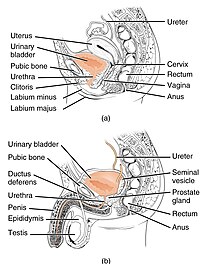
Photo from wikipedia
Due to growing social acceptance, there has been an increasing number of gender-affirmation surgeries performed in North America. Most research in this patient population focuses on surgical outcomes and advancing… Click to show full abstract
Due to growing social acceptance, there has been an increasing number of gender-affirmation surgeries performed in North America. Most research in this patient population focuses on surgical outcomes and advancing techniques. However, little work has been done to study functional outcomes. To better evaluate urinary dysfunction in the postphalloplasty trans men patient population, our group developed a novel patient-reported outcome instrument – the postphalloplasty urinary function test (PP UFT) and protocol to measure postvoid urethral volume (PVUR), and we present our preliminary results. We conducted a cross-sectional pilot study in a cohort of 15 adult trans men who had undergone phalloplasty with urethral lengthening surgery between 2018 and 2021. Patients had stable urinary function via the neophallus at the time of survey. Patients filled out the PP UFT and were asked to record their PVUR as per our protocol. The average PP UFT score was 8.9 out of 40 and the average quality-of-life (QOL) score was 2.6. Postvoid dribbling constituted the major complaint and on average comprised 63.2% of the reported PP UFT score. The average PVUR was 2.2 ml (range: 0.5–5.6 ml). There was a positive correlation between higher PP UFT and worse-reported quality of life (P < 0.01; R2 = 0.4). Current questionnaires accepted in cis-male urology have limitations for accurately capturing urinary dysfunction in this specific patient group. The combination of PP UFT and PVUR measurement offers potential for quantifying urinary function and quality of life in patients who undergo phalloplasty. Future studies will validate these instruments.
Journal Title: Asian Journal of Andrology
Year Published: 2022
Link to full text (if available)
Share on Social Media: Sign Up to like & get
recommendations!